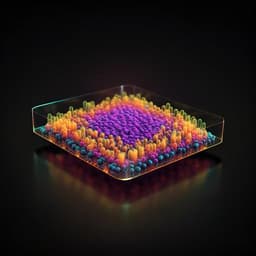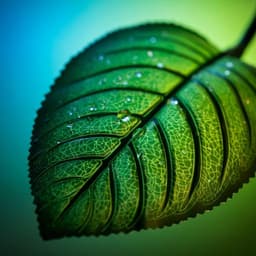
Engineering and Technology
Manufacturing supported loose-nanofiltration polymeric membranes with eco-friendly solvents on an R2R System
D. Lu, K. Jung, et al.
Explore the innovative development of loose nanofiltration membranes created by an expert team led by David Lu and Kwangjun Jung. This fascinating research highlights the use of eco-friendly co-solvents and cutting-edge slot die coating technology to achieve high-performance membranes that combine sustainability with scalable manufacturing.
Playback language: English
Introduction
Membrane separation technologies offer significant advantages over traditional methods, including reduced manufacturing costs, lower energy consumption, and operational flexibility while maintaining high permeability and selectivity. Polymeric membranes, due to their versatility in material selection and tailoring, are particularly suitable for a wide range of industrial separations, such as water treatment, bioseparations, and gas separations. A key area of research focuses on developing loose nanofiltration (LNF) membranes, which bridge the gap between ultrafiltration (UF) and nanofiltration (NF) membranes. LNF membranes offer the advantage of high solute rejection combined with significantly higher permeability than tight NF membranes and higher selectivity than UF membranes, creating a high demand for scalable and environmentally friendly manufacturing processes. Current methods, primarily phase inversion techniques like nonsolvent-induced phase separation (NIPS), often rely on hazardous and environmentally unfriendly solvents. This study addresses the challenge of scaling up LNF membrane production while incorporating sustainable materials and processes, employing slot die coating (SDC) on a roll-to-roll (R2R) system with eco-friendly solvents.
Literature Review
Conventional polymeric membrane fabrication often utilizes phase inversion methods, with nonsolvent-induced phase separation (NIPS) being the dominant technique. In NIPS, a dope solution (polymer dissolved in solvent) is cast onto a substrate and immersed in a nonsolvent bath, leading to phase separation and membrane formation. Bench-scale production often uses doctor blade extrusion (DBE), spin coating, or dip coating. However, DBE is not easily scalable to R2R systems. Slot die coating (SDC), a technique widely used for thin-film manufacturing, offers better scalability and control over film thickness, making it ideal for R2R integration. While SDC has been applied to membrane fabrication, studies focusing on R2R production of membranes for clean water applications, particularly incorporating support layers and eco-friendly solvents, are limited. The choice of support layer material significantly impacts membrane morphology and performance, with nonwoven polyethylene terephthalate (PET) fabrics showing promise due to their permeability and strength. Furthermore, the use of traditional solvents in NIPS poses environmental and health concerns, leading to research into eco-friendly alternatives like PolarClean and gamma-valerolactone (GVL), which offer biodegradability and reduced toxicity. Although some studies have explored eco-friendly solvents in bench-scale membrane production, integrating them with support layers and scaling up via SDC on an R2R system remains largely unexplored.
Methodology
This study investigated the fabrication of loose NF flat sheet membranes using SDC on an R2R system, with and without a support layer. A polysulfone (PSf) polymer was selected due to its widespread use in NF/UF membranes and low environmental impact. The dope solution comprised PSf dissolved in a 3:1 mixture of PolarClean and GVL. Rheological properties (dynamic viscosity, surface tension, capillary number) of the dope solution were characterized using a rheometer and goniometer. The coating window (range of parameters yielding uniform films without defects like air entrainment or dripping) was determined by systematically varying flow rate and substrate speed while monitoring the coating process using a camera and microscope. To incorporate a support layer (Hollytex® 3265 nonwoven PET fabric), a pre-wetting step using the dope solution was implemented to minimize solution penetration and enhance interfacial adhesion. Membranes were prepared with different configurations: direct coating onto a glass plate, direct coating onto the support layer, and coating onto a pre-wetted (with dope solution) support layer, with and without compression. For comparison, membranes were also fabricated using bench-scale DBE. Membrane morphology was characterized using scanning electron microscopy (SEM), and pore size and total porosity were determined using ImageJ analysis and gas pycnometry, respectively. Membrane performance (permeability and solute rejection) was evaluated via dead-end filtration using bovine serum albumin (BSA) and sodium alginate (SA) as model solutes, and adhesion strength between the membrane and support layer was assessed using a crosscut adhesion test. The results were compared to existing literature on LNF membranes prepared using PolarClean, as well as commercial UF and NF membranes.
Key Findings
The dynamic viscosity of the PSf-PolarClean-GVL dope solution exhibited shear-thinning behavior, suitable for both DBE and SDC. The capillary number indicated that viscous forces dominated during coating. A partial coating window was established, showing the range of flow rates and substrate speeds producing uniform membranes without defects. The pre-wetting treatment with the dope solution significantly improved interfacial adhesion between the membrane and support layer. SEM analysis revealed a sponge-like pore structure consistent across all membrane samples, with a thin selective skin layer at the top. Microbubbles were observed at the membrane-support layer interface in some SDC samples, but these did not significantly affect membrane performance. Mean pore sizes were consistent across different fabrication methods and support layer configurations, indicating that the dope solution properties were the primary determinants of pore structure. Gas pycnometry revealed that the support layer had a significant impact on membrane porosity. The pre-wetting step improved the adhesion between the membrane and the support layer. The dead-end filtration experiments showed that the SDC membranes had a comparable performance to the DBE membranes in terms of BSA rejection and permeability. Pre-wetted and uncompressed SDC membranes (SDC-3) exhibited the highest BSA rejection (99.20% ± 1.31%) and adequate permeability (70.5 ± 8.33 LMH/bar). Both SDC-3 and SDC-4 exhibited high SA rejection (above 50%), indicating potential for improved natural organic matter separation. The pure water permeability and solute rejection of SDC-3 and SDC-4 were comparable to those reported for other LNF membranes prepared using PolarClean and commercial UF/NF membranes. The compression of the support layer did not enhance BSA rejection, despite increasing the permeability.
Discussion
This study successfully demonstrated the scale-up of LNF membrane fabrication using SDC on an R2R system with eco-friendly solvents. The rheological characterization of the dope solution guided the selection of optimal SDC parameters. The incorporation of a support layer and the pre-wetting step proved crucial for achieving high-performance membranes with strong adhesion and minimal thickness variations. The comparable performance between SDC and DBE membranes validates SDC as a viable technique for scaling up membrane production. The high BSA rejection and adequate permeability observed in several SDC membrane configurations highlight the potential of this approach for practical water treatment applications. The improved SA rejection in SDC membranes suggests that this method can enhance the removal of natural organic matter. The presence of microbubbles at the membrane-support interface, while observed, did not compromise performance, signifying that the process is robust. The use of eco-friendly solvents reduces the environmental impact associated with traditional membrane manufacturing.
Conclusion
This research successfully demonstrated the feasibility of manufacturing supported loose nanofiltration membranes using slot die coating on a roll-to-roll system with eco-friendly solvents. The results showed comparable performance to bench-scale methods, highlighting the potential for scalable, sustainable membrane production. Future research could focus on further optimization of SDC parameters, exploring alternative support layer materials, and investigating the long-term stability and fouling resistance of these membranes under various operating conditions.
Limitations
The study focused on short-term filtration experiments. Long-term performance, fouling behavior, and cleaning protocols remain to be investigated. The coating window analysis was limited to a partial range of parameters. A more comprehensive investigation covering a wider range of conditions may reveal additional insights into the process stability. The microbubble formation at the membrane-support interface, while not impacting performance in this study, warrants further examination to potentially eliminate this phenomenon for improved membrane quality. The sample size for several characterization methods was relatively small, which could impact the precision and accuracy of certain data points. More replicates could improve the statistical significance of the findings. The comparison to commercial membranes was based on limited data from the literature and did not account for potential differences in membrane testing and operating conditions.
Related Publications
Explore these studies to deepen your understanding of the subject.







